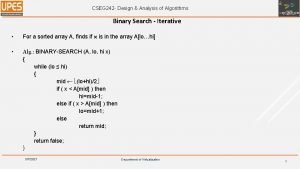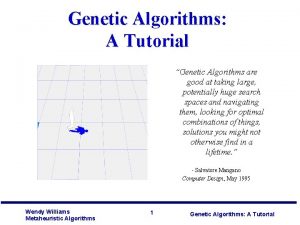ANALYSIS AND DESIGN OF ALGORITHMS CSEN 707 Tutorial
![ANALYSIS AND DESIGN OF ALGORITHMS [CSEN 707] Tutorial 2 By: Mariham Wasfy ANALYSIS AND DESIGN OF ALGORITHMS [CSEN 707] Tutorial 2 By: Mariham Wasfy](https://slidetodoc.com/presentation_image/cd1b23d8568f0aa9eae2287f995f56bc/image-1.jpg)


















- Slides: 19
![ANALYSIS AND DESIGN OF ALGORITHMS CSEN 707 Tutorial 2 By Mariham Wasfy ANALYSIS AND DESIGN OF ALGORITHMS [CSEN 707] Tutorial 2 By: Mariham Wasfy](https://slidetodoc.com/presentation_image/cd1b23d8568f0aa9eae2287f995f56bc/image-1.jpg)
ANALYSIS AND DESIGN OF ALGORITHMS [CSEN 707] Tutorial 2 By: Mariham Wasfy

Content § Growth of functions § Asymptotic Notation § Comparison of function

GROWTH OF FUNCTIONS

Growth of functions The order of growth of the running time of an algorithm, gives a simple characterization of the algorithm’s efficiency and also allows us to compare the relative performance of alternative Algorithms (what will happen when system grows).

Complexity Algorithmic complexity is concerned about how fast or slow particular algorithm performs. Complexity Time complexity is our main concern in networks problems Time Quantifies the amount of time taken by an algorithm to run as a function of the length of the input Space Quantifies the amount of space or memory taken by an algorithm to run as a function of the length of the input.

ASYMPTOTIC NOTATIONS

Asymptotic Notations Rate of the growth: how the running time grows as the input grows. Asymptotic means not exact approach certain value Asymptotic Notations Big Small Oh Omega Theta Oh Omega O(n) Ω(n) Θ(n) o(n) Ω(n)

Big Oh O(n) The O notation provides an asymptotic upper bound. Worst case. Less than or equal. We use O-notation. For a given function G(n), we denote by O(g(n)) pronounced “big-oh of g of n” or sometimes just “oh of g of n” the set of functions cg(n) f(n)

Big Omega Ω(n) The Ω notation provides an asymptotic lower bound. Best case. Greater than or equal. We use Ω -notation. For a given function G(n), we denote by Ω (g(n)) pronounced “big-omega of g of n” or sometimes just “omega of g of n” the set of functions. f(n) cg(n) n

Big Theta θ(n) The θ notation provides an asymptotic tight bound. Average case. Equal. We use θ-notation. A function f (n) belongs to the set g(n) if there exist positive constants c 1 and c 2 such that it can be “sandwiched” between c 1 g(n) and c 2 g(n), for sufficiently large n c 2 g(n) f(n) c 1 g(n) n 0

Small Oh o(n) The o notation provides to denote an upper bound that is not asymptotically tight. Worst case. Less than. We use o-notation. For a given function G(n), we denote by o(g(n)) pronounced “little-oh of g of n” c 3 ⋅ g c 2 ⋅ g c 1 ⋅ g n 3 n 2 n 1 f

Small Omega ω(n) The ω notation provides to denote an lower bound that is not asymptotically tight. Best case. Greater than. We use ω -notation. For a given function G(n), we denote by ω (g(n)) pronounced ““little-omega of g of n” f c 3 ⋅ g c 2 ⋅ g c 1 ⋅ g n 1 n 2 n 3

Limit Test Asymptotic Notations Big Theta Θ(n) Omega Ω(n) Oh O(n)

COMPARISON OF FUNCTION

Transitivity

Relativity

Symmetry

Transpose Symmetry

Theorem
 Csen
Csen The boeing 747 is twice bigger than the boeing 707
The boeing 747 is twice bigger than the boeing 707 Opwekking 784
Opwekking 784 Modelo eclipse
Modelo eclipse 707 meaning in islam
707 meaning in islam Microcomputer
Microcomputer Design and analysis of algorithms syllabus
Design and analysis of algorithms syllabus Introduction of design and analysis of algorithms
Introduction of design and analysis of algorithms Binary search in design and analysis of algorithms
Binary search in design and analysis of algorithms Introduction to the design and analysis of algorithms
Introduction to the design and analysis of algorithms Design and analysis of algorithms
Design and analysis of algorithms Design and analysis of algorithms
Design and analysis of algorithms Comp 482
Comp 482 Data structures and algorithms tutorial
Data structures and algorithms tutorial Dsp programming tutorial
Dsp programming tutorial Genetic algorithms tutorial
Genetic algorithms tutorial Association analysis: basic concepts and algorithms
Association analysis: basic concepts and algorithms Cluster analysis: basic concepts and algorithms
Cluster analysis: basic concepts and algorithms Randomized algorithms and probabilistic analysis
Randomized algorithms and probabilistic analysis Cluster analysis basic concepts and algorithms
Cluster analysis basic concepts and algorithms





































